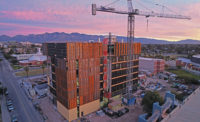A major interchange is undergoing a role reversal in Arizona's second-largest metropolitan area. Designed to solve traffic headaches and a dire safety problem, the Interstate-10, Prince to Ruthrauff roads project in Tucson is "flipping" the grade of Prince Road so that it will pass over, instead of under, I-10.
The revamp is part of a $76.4-million effort to widen I-10 along a two-mile stretch to eight lanes from six. Crews have to contend with six lanes of traffic at all times, a major railroad route and multiple utilities—all while keeping an eye out for potential archaeological finds.
Utilitarian
Since last fall, nearly all of the project's first 180 days have been devoted to relocating 15 separate utility lines that criss-cross the construction zone. Utilities include high-pressure petroleum and gas lines, sewer and water lines, electric power and telecommunications. "It was basically an underground utility interchange," says Jody Rodriguez, utility coordinator with the Tucson office of URS, a design subconsultant.
Crews relocated 72-in.-dia and 78-in.-dia sewer lines with flows of around 22 million gallons per day. The contractor advanced four jack-and-bore operations, including a 450-ft-long, 60-in.-dia casing under I-10 to reroute sewer flow.
As is typical, crews found utility lines that didn't match the positions indicated on the as-builts. Surprisingly, some of the existing joint trenches were encased in concrete and had to be carefully demolished—in one case, while avoiding damage to a major electrical line, says Edie Griffith-Mettey, senior project manager in the Tucson office of prime consultant AECOM.
Nevertheless, "we've been able to accomplish most all the relocations at this point without a delay to the overall project," says Todd Emery, district engineer with the Arizona Dept. of Transportation.
Besides allowing for better access and maintenance, designers had to figure out a way to protect the utilities from the weight of huge embankments and retaining walls required to elevate Prince Road. Thus, they corralled the utilities into a single utility corridor spanned by a 135-ft-long bridge. "Initially, we were going to put in a protection slab. But when we started doing the cost analysis, it was just as expensive to build a bridge," Rodriguez says.







